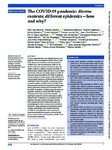The COVID-19 pandemic: diverse contexts; different epidemics—how and why?
Van Damme, Wim
Dahake, Ritwik
Delamou, Alexandre
Ingelbeen, Brecht
Wouters, Edwin
Vanham, Guido
van de Pas, Remco
Dossou, Jean-Paul
Ir, Por
Abimbola, Seye
Van der Borght, Stefaan
Narayanan, Devadasan
Bloom, Gerald
Van Engelgem, Ian
Ahmed, Mohamed Ali Ag
Kiendrébéogo, Joël Arthur
Verdonck, Kristien
De Brouwere, Vincent
Bello, Kéfilath
Kloos, Helmut
Aaby, Peter
Kalk, Andreas
Al-Awlaqi, Sameh
Prashanth, NS
Muyembe-Tamfum, Jean-Jacques
Mbala, Placide
Ahuka-Mundeke, Steve
Assefa, Yibeltal
It is very exceptional that a new disease becomes a true pandemic. Since its emergence in Wuhan, China, in late 2019, severe acute respiratory syndrome coronavirus 2 (SARS-CoV-2), the virus that causes COVID-19, has spread to nearly all countries of the world in only a few months. However, in different countries, the COVID-19 epidemic takes variable shapes and forms in how it affects communities. Until now, the insights gained on COVID-19 have been largely dominated by the COVID-19 epidemics and the lockdowns in China, Europe and the USA. But this variety of global trajectories is little described, analysed or understood. In only a few months, an enormous amount of scientific evidence on SARS-CoV-2 and COVID-19 has been uncovered (knowns). But important knowledge gaps remain (unknowns). Learning from the variety of ways the COVID-19 epidemic is unfolding across the globe can potentially contribute to solving the COVID-19 puzzle. This paper tries to make sense of this variability—by exploring the important role that context plays in these different COVID-19 epidemics; by comparing COVID-19 epidemics with other respiratory diseases, including other coronaviruses that circulate continuously; and by highlighting the critical unknowns and uncertainties that remain. These unknowns and uncertainties require a deeper understanding of the variable trajectories of COVID-19. Unravelling them will be important for discerning potential future scenarios, such as the first wave in virgin territories still untouched by COVID-19 and for future waves elsewhere.
Dateien zu dieser Publikation

